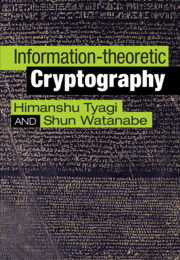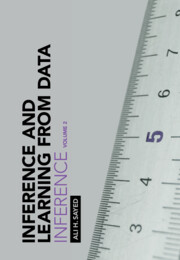Refine search
Actions for selected content:
6791 results in Communications and signal processing
14 - Bit Commitment from Correlated Randomness
- from Part II - Internal Adversary: Secure Computation
-
- Book:
- Information-theoretic Cryptography
- Published online:
- 23 March 2023
- Print publication:
- 13 April 2023, pp 290-311
-
- Chapter
- Export citation
Preface
-
- Book:
- Information-theoretic Cryptography
- Published online:
- 23 March 2023
- Print publication:
- 13 April 2023, pp xiii-xiv
-
- Chapter
- Export citation
8 - Authentication
- from Part I - External Adversary: Encryption, Authentication, Secret Key
-
- Book:
- Information-theoretic Cryptography
- Published online:
- 23 March 2023
- Print publication:
- 13 April 2023, pp 139-157
-
- Chapter
- Export citation
15 - Active Adversary and Composable Security
- from Part II - Internal Adversary: Secure Computation
-
- Book:
- Information-theoretic Cryptography
- Published online:
- 23 March 2023
- Print publication:
- 13 April 2023, pp 312-361
-
- Chapter
- Export citation
12 - Two-party Secure Computation for a Passive Adversary
- from Part II - Internal Adversary: Secure Computation
-
- Book:
- Information-theoretic Cryptography
- Published online:
- 23 March 2023
- Print publication:
- 13 April 2023, pp 227-261
-
- Chapter
- Export citation

Information-theoretic Cryptography
-
- Published online:
- 23 March 2023
- Print publication:
- 13 April 2023

Inference and Learning from Data
- Inference
-
- Published online:
- 17 March 2023
- Print publication:
- 22 December 2022
-
- Textbook
- Export citation
9 - Quotient manifolds
-
- Book:
- An Introduction to Optimization on Smooth Manifolds
- Published online:
- 09 March 2023
- Print publication:
- 16 March 2023, pp 205-251
-
- Chapter
- Export citation
8 - General manifolds
-
- Book:
- An Introduction to Optimization on Smooth Manifolds
- Published online:
- 09 March 2023
- Print publication:
- 16 March 2023, pp 176-204
-
- Chapter
- Export citation
5 - Embedded geometry: second order
-
- Book:
- An Introduction to Optimization on Smooth Manifolds
- Published online:
- 09 March 2023
- Print publication:
- 16 March 2023, pp 79-114
-
- Chapter
- Export citation
Dedication
-
- Book:
- Introduction to Digital Communications
- Published online:
- 24 April 2023
- Print publication:
- 16 March 2023, pp vi-vi
-
- Chapter
- Export citation
Index
-
- Book:
- Introduction to Digital Communications
- Published online:
- 24 April 2023
- Print publication:
- 16 March 2023, pp 648-650
-
- Chapter
- Export citation
Reviews
-
- Book:
- Introduction to Digital Communications
- Published online:
- 24 April 2023
- Print publication:
- 16 March 2023, pp ii-iii
-
- Chapter
- Export citation
9 - Convolutional Codes
-
- Book:
- Introduction to Digital Communications
- Published online:
- 24 April 2023
- Print publication:
- 16 March 2023, pp 557-596
-
- Chapter
- Export citation
1 - Introduction
-
- Book:
- An Introduction to Optimization on Smooth Manifolds
- Published online:
- 09 March 2023
- Print publication:
- 16 March 2023, pp 1-3
-
- Chapter
- Export citation
Acknowledgments
-
- Book:
- Introduction to Digital Communications
- Published online:
- 24 April 2023
- Print publication:
- 16 March 2023, pp xiv-xiv
-
- Chapter
- Export citation
2 - Simple examples
-
- Book:
- An Introduction to Optimization on Smooth Manifolds
- Published online:
- 09 March 2023
- Print publication:
- 16 March 2023, pp 4-15
-
- Chapter
- Export citation
4 - Error Probability for Binary Signals
-
- Book:
- Introduction to Digital Communications
- Published online:
- 24 April 2023
- Print publication:
- 16 March 2023, pp 196-249
-
- Chapter
- Export citation
References
-
- Book:
- Introduction to Digital Communications
- Published online:
- 24 April 2023
- Print publication:
- 16 March 2023, pp 645-647
-
- Chapter
- Export citation
1 - Fundamentals of Digital Communications
-
- Book:
- Introduction to Digital Communications
- Published online:
- 24 April 2023
- Print publication:
- 16 March 2023, pp 1-45
-
- Chapter
- Export citation
